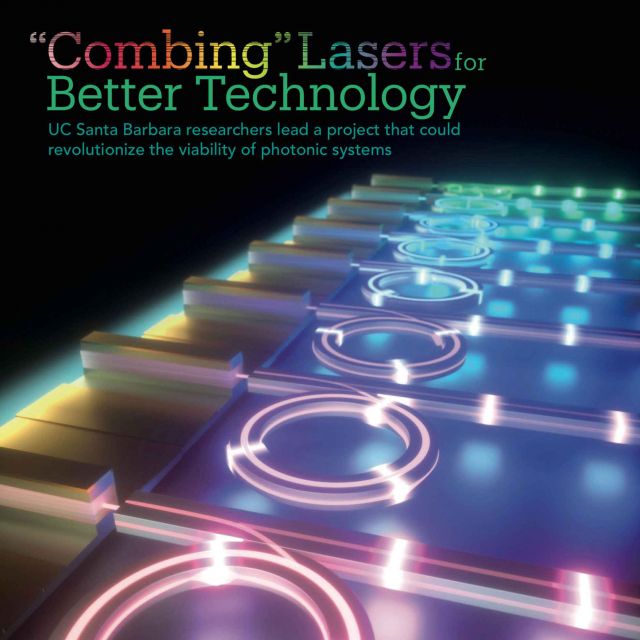Bowers "'Combing' Laser Colors'"
ECE Professor John Bowers' team leads a project that could revolutionize the viability of photonics systems

Excerpt from COE/CLS Convergence (W21) article "'Combing Lasers' for Better Technology"
While computer technology continues to progress rapidly, the growing power demands of data centers have created a bottleneck by pushing electrical input-output systems to their physical limits. Maintaining progress will require a significant shift in how computers are built.
In recent years, photonics — which refers to revolutionary systems in which light waves are used to transmit data faster than electronic systems can while also generating less heat — has come to the fore. It has provided a solution to the chip-to-chip bandwidth problem by enabling higher-bandwidth servers that can be farther apart and require less energy.
One element of the photonics revolution was advanced when John Bowers, the Fred Kavli Distinguished Professor in the Department of Electrical and Computer Engineering at UC Santa Barbara, along with UCSB colleagues and researchers at Intel, demonstrated a technology called the silicon laser. Fifteen years later, Intel now provides millions of silicon photonic transceivers to data centers around the world.
"The entire internet is now driven by photonics," says Bowers, who directs the College of Engineering's Institute for Energy Efficiency and led the collaborative research effort.
Now, Bowers has played a lead role in another important discovery in silicon photonics, the result, this time, of a collaboration involving UCSB, Caltech, and the Swiss Federal Institute of Technology Lausanne (EPFL). In their groundbreaking work, featured in Nature, the researchers managed to simplify and condense a complex optical system into a small package that significantly reduces the cost of production and can be integrated easily into traditional silico-chip production.
The explosion of data traffic in recent years has meant that each individual silicon photonic chip must handle data at an ever-increasing rate. The most efficient way to address this demand is by using multicolor laser light to transmit information. The more laser colors you have, the more information can be carried.
A laser typically generates only one color of light at a time, with the result, Bowers says, that "You might need fifty or more lasers in that chip for that purpose, each one generating a single color of light. But using fifty lasers has a number of drawbacks. It's expensive and also rather inefficient in terms of power use. What's more, the frequency of light that each laser produces can fluctuate slightly due to noise and heat. With multiple lasers, the frequencies can even drift into each other, much as early radio stations did."
A technology called "optical frequency combs" provides a promising solution to address this problem of laser drift. The comb is a collection of equally spaced frequencies of laser light. Plotting the frequencies reveals spikes and dips that resemble the teeth on a hair comb and the spaces between — hence the name.
Until now, generating an optical frequency comb required bulky, expensive equipment. But, by taking an integrated-photonics approach, Bowers's team was able to demonstrate the smallest comb generator in the world, which resolves all the problems previously associated with the technology. The structure is significantly smaller and cheaper than former versions, can be integrated into a small chip on silicon, and requires less power to operate.
The configuration of the system is rather simple, consisting of a commercially available feedback laser and a silicon nitride photonic chip. "What we have is a source that generates all these colors out of just one laser and one chip," Bowers says. "That's what's significant about this." It is a classic case of getting more from less.
The new technology is also much more convenient to operate. Previously, generating a stable comb had been a tricky endeavor. Researchers had to modulate the frequency and adjust power with extreme precision to produce a coherent comb state, called a soliton, and that process was not guaranteed to generate such a state every time. "The new approach makes the process as easy as switching on a room light," says co-author Kerry Vahala, a professor of applied physics and information science and technology at Caltech.
COE/CLS Convergence magazine (W21) - "Combing Lasers for Better Technology" (full article pg. 32-33)